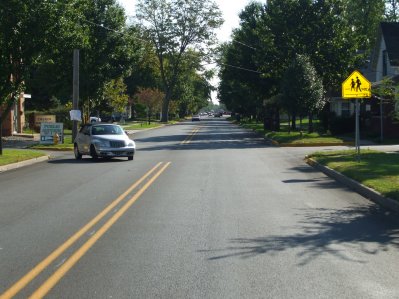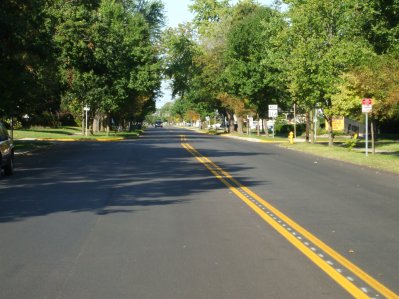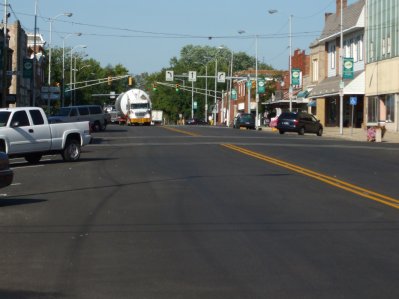Asphalt Pavement Association of Indiana
Paving Through Thick and Thin
By Chuck MacDonald
To be considered a top-notch paving contractor, a company must build quality roads, on time, and on budget. That’s a given. Brooks Construction, of
For the latter four projects Brooks utilized its attention to quality to construct award-winning pavements requiring 48,500 tons of asphalt for US 20, 9,000 tons of asphalt for US 33, and 8,700 tons of asphalt for SR 3. The mill-and-overlay work on SR 28 used 10,000 tons of asphalt for the 6-mile long job. Brooks used reclaimed asphalt pavement (RAP) in each of those projects as is allowed by the Indiana DOT. The other two jobs presented Brooks with some of its most unusual construction challenges of the year: the building of a “floating pavement” for US 6 and construction of an ultrathin bonded course for SR 114.
Dealing with poor subgrade
The
Because of the unstable subgrade materials, Brooks removed material and used a floating pavement section supported with Geofoam Expanded Polystyrene. “In some areas the peat was 35 feet deep,” said Brian Beattie, highway operations manager for Brooks. “To excavate all the peat and replace it with sand or other material would not have worked because that meant encountering the water table. Also, that would have been extremely costly.”
Working with a design developed by the Indiana DOT, Brooks constructed a floating pavement comprised of a layer of Geofoam blocks with a 10-inch thick rigid pavement slab on top. Geofoam Expanded Polystyrene is a non-biodegradable plastic foam. It is similar to the Extruded Polystyrene often used in disposable coffee cups. The Geofoam layer varied from 20 inches to 40 inches thick, depending on the depth of weak subgrade it was replacing. Once this underground bridge over the unstable subgrade was completed, the construction team could begin to build the asphalt pavement.
Another obstacle was distributing traffic along the five-lane highway so motorists could proceed both east and west while the project was under construction. In many places the peat deposits were located under all lanes of traffic, requiring the road crew to build half of the underground bridge, and then complete it when traffic was switched over for the second half of the project.
Building the asphalt pavement
The Brooks paving team met the INDOT requirements for compaction of 94 percent +- 2 percent. The two-year project required 48,000 tons of Superpave mix and was completed in July, 2008.
“I’ve been in the paving business for 15 years and had never seen a project like this done on a major road,” said Beattie. The Brooks workers also built stormwater and sewer drains in addition to their pavement work.
Mir Zaheer was the Geotechnical design group leader for the project at the Indiana DOT. Zaheer was confident that the design would be successful due to the fact that a few roadways in
Usually buoyancy if designed properly would not be a problem. The sections were designed with an adequate amount of gravel and pavement on top of the Geofoam. The weight was sufficient to hold the blocks down during normal rain or 100-year flooding. Brooks Construction did have some anxious moments, during some very unusual flooding when the blocks were in place and the pavements had not been constructed on top to weigh the blocks down. The Geofoam blocks heaved a couple of inches, but did not float away. Once the floodwater level receded, the Geofoam blocks settled back to an acceptable level and the road construction was able to proceed normally after the subgrade dried.
“The Geofoam Expanded Polystyrene blocks were cost-effective and the most feasible solution to the subgrade problem,” said Zaheer. “Brooks did an excellent job on this construction project.”
Ultrathin bonded course
The unusual requirements of the project caused Brooks to import specialized paving equipment and a crew experienced with using the equipment. Beattie reported that the paving process went smoothly and within 15 minutes after paving traffic was allowed to drive on the new surface.
Brooks’ contractors had to haul the emulsion 45-minutes from its plant with the material maintaining a minimum of 300o in order for it to flash properly under the screed. In addition, the paving crew had to first seal all cracks in the old pavement, or the emulsion would instantly drain downward into the cracks and not contact the hot mix to create the bond. Thermoplastic markings had to be removed before the paving began in order to make sure that the best bond would be created between the old and new pavements.
The hot mix contained 5.2 percent asphalt cement and used a PG 70-28 binder. The mix used 15 percent fine aggregate and 85 percent coarse aggregate. The project was 0.75 miles in length and varied in width up to 78 feet to accommodate the changing width of the road as it traveled through the town. No RAP was used in the ultrathin surfacing process.
Although the job was unusual in the state, Brooks committed to a three-year warranty of it. “We completed the job in July, 2008, and it is performing well,” said Beattie.
Todd Shields, pavement preservation engineer for INDOT, saw the project as an excellent use of resources to preserve the road that travels through the town of







